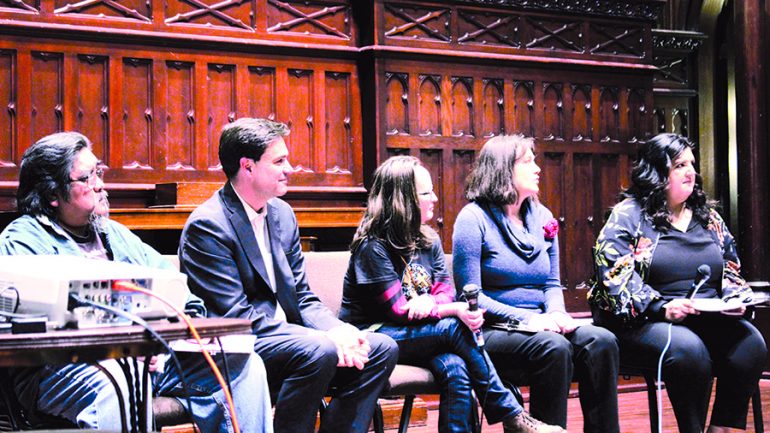The City Club of Portland (CCP) recognized that some of the citizens of Portland have either experienced houselessness themselves or know someone who has. Because of this, CCP held an event entitled The Street Truth: What It Means to be Homeless in Portland at the First Congregational United Church of Christ on March 14th.
The event featured a short documentary created by Street Roots and Here Together, that interviewed individuals about their experiences with houselessness in Portland. Several Street Roots vendors told stories in person, as well.
Topics touched on included the perception of those who are experiencing houselessness, the causes and potential long-lasting personal impacts.
City Club of Portland posted a video of the event on youtube.
Forum on Reports
The Oregon Community Foundation (OCF) commissioned ECONorthwest, the Pacific Northwest’s largest independent economic research firm, to analyze factors driving houselessness and housing insecurity in the region. Their first report, “Homelessness in the Portland Region,” was released October 2018. The second report, “Homelessness in Oregon,” that was released in March 2019. Both reports include a review of trends seen in houseless insecurity, causes and a comprehensive framework of suggested solutions. President of ECONorthwest, John Tapogna, was there to discuss the reports with a forum that, in part, included the executive director of Street Roots, Kaia Sand, and several vendors.
Insights provided by the report include: why Oregon has such a large houseless population, trends in the houseless population related to episodic and chronic houselessness seen since the recession, why high rents are the leading cause of houselessness, and why houselessness has a disproportionate effect on ethnic minorities.
The report recognizes that “Governor Kate Brown has advanced a range of initiatives aimed at preventing and addressing homelessness—with a special emphasis on children, veterans, and the chronically homeless,” and that cities like Portland and other counties are building up programs to address the issue but that “Oregon’s policy discussion might improve if homelessness were described as two related crises.”
“What makes Portland different and what makes the crisis in this city more severe than in other places has to do with the high cost of housing,” Tapogna stated.
While the report is steeped in statistical analysis and data collection, it challenges the Point-In-Time (PIT) system the city uses to quantify the houseless population, specifically noting inaccuracies pertaining to students and children experiencing houselessness.
Reports:
“Homeless counts are down since the Great Recession but have edged up recently for two key subpopulations—the unsheltered homeless and the chronically homeless.”
Although the rate of houselessness in Oregon have declined since the 2008 Great Recession, the report notes that houselessness could have declined more had the housing market in Portland been functioning “better.” In the 2000s, Portland, like many other regions redistributed limited resources from shelters to permanent housing solutions. But what could have been an effective model was broken by what the report calls Portland’s “tight housing market,” and high rents drove households into “worst-case needs status,” susceptible to houselessness in the case of personal crises while “evidence-based solution to housing re-entry—deep, sustained rental subsidies—were expensive and in short supply.” To sum it up, the “inflow to shelters exceeded outflows into permanent housing,” and the unsheltered population started to grow. But how the shelter system “scales from here is unclear,” since there aren’t any standard ratios or formulas in place that synthesize data from shelters with trends in the housing market.
“Oregon’s homeless crisis stretches across the state.”
The statewide report references several regional analyses that indicate “Oregon’s homeless crisis stretches across the state.” For example, Jackson County has reached a seven-year high in their houseless population; the number of people living in Central Oregon sleeping in cars, on the street, and under bridges increased by around 25 percent in 2017–-2018; the report adds that Oregon’s houseless population disproportionately contributes to the national average.
It further asserts that “Oregon’s high rents make the crisis more severe than those in most states and, left unabated, they will contribute to a growing homeless population going forward.” Further exacerbating the issue is that “Oregon has not expanded its emergency shelter capacity to match the size of its homeless population; and, in 2018, [Oregon] had the second highest rate of unsheltered homeless people in the country,” as well as having “the third highest rate of chronically homeless people in the U.S.”
“Oregon faces two, related homelessness crises.”
Episodic vs chronic houselessness
The statewide report references two “crises” that affect two different subpopulations.
One crisis affects roughly 3,400 chronically houseless individuals, a population of individuals with “highly challenging personal circumstances who will struggle to remain housed” without “sustained intensive support,” regardless of cost or job prospects. These individuals face “persistent barriers to housing, such as mental and physical disabilities, substance abuse issues, criminal records, and/or other problematic circumstances.” Chronically homeless refers to those who are homeless for more than a year or who face repeated spells of homelessness over time. The number in this subpopulation has remained above levels recorded during the recession.
The second crisis affects at least 150,000 households: the episodic, short-term houseless and the growing population of renters on the verge of houselessness because of burden of housing cost.
Tapogna explained those households “are at high risk on any given night,” and subsequently, “any disruption to their life, an electricity bill, a job loss, an eviction notice, and domestic violence can tip that family out of housing and onto the street.”
The Portland Report refers to HUD PIT counts: in 2017, on an average night in Portland, there were nearly 4,300 episodic houseless individuals and almost 1,700 chronically houseless individuals. It also included numbers that HUD reported in 2015: there were 349,000 renter households in Portland. Of those, 125,000 were considered “very low income,” by HUD’s definition; 32,000 (25 percent) received federal housing assistance; 56,000 (45 percent) did not receive assistance and had severe housing problems (paid more than half of income to rent and utilities and/or lived in inadequate housing).
Several recommendations
The final section of the report offers a “Comprehensive Framework of Responses to Homelessness.” Based on a review of current policy and programming, private and public expenditures and funding issues, the report outlines “the most cost-effective approaches to moving the state’s population experiencing homelessness into stable housing.”
Build more housing units: The root of Oregon’s houselessness crisis, per the report, is a “dysfunctional, undersupplied housing market.” The state has a practice of building 63 housing units for every 100 new households built, which the report characterizes as insufficient. If the state doesn’t “accelerate housing supply at all price points,” the report warns vacancy rates will continue to decrease, prices will continue to rise, and any other recommendations would be less effective. Once undersupply is addressed, localities would have to smooth out zoning issues and local politics, as “current residents usually like their neighborhoods the way they are.” A ban on single-family zoning in large communities and increased housing density within transit corridors is on the agenda for current state legislature, and the report suggests lawmakers include fiscal rewards and penalties to policy packages as a way of incentivizing housing goals.
More affordable housing units with stronger connection to service sectors:
an increase of permanent supportive housing with more connections between the houseless services and affordable housing sectors.
Evaluating policies in place and ways the state could supplement federal programs. For example, shift locally-funded, short-term vouchers to the federally-assisted individuals that have less severe needs while targeting a larger share of the federal-funding and long-term vouchers to the formerly houseless.
More emergency shelter beds to ensure the safety of vulnerable populations, as well as an expansion of the amount of emergency shelter beds, but not in expense of the previously mentioned recommendations.
Additional reporting by Margo Craig.





